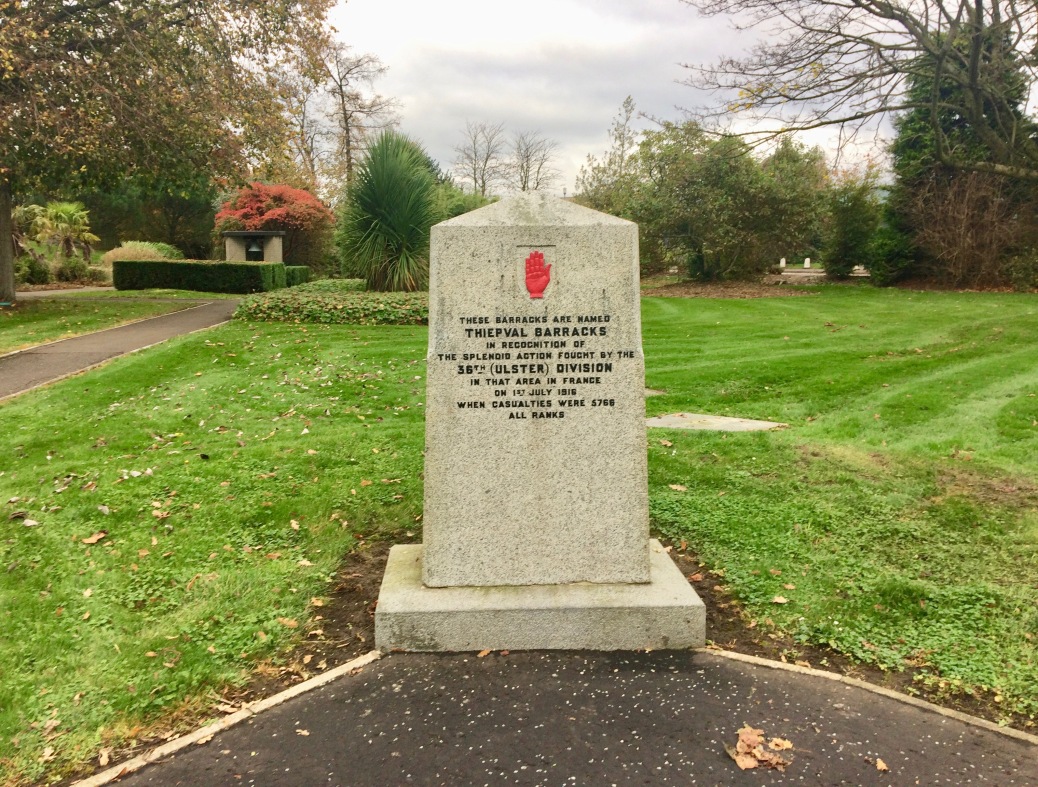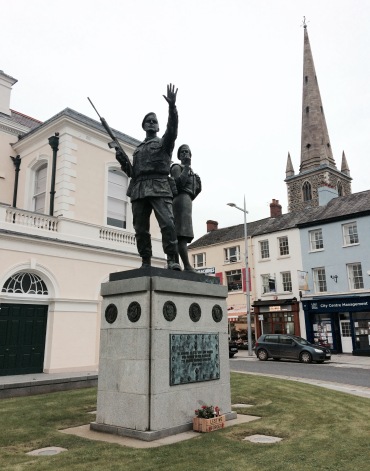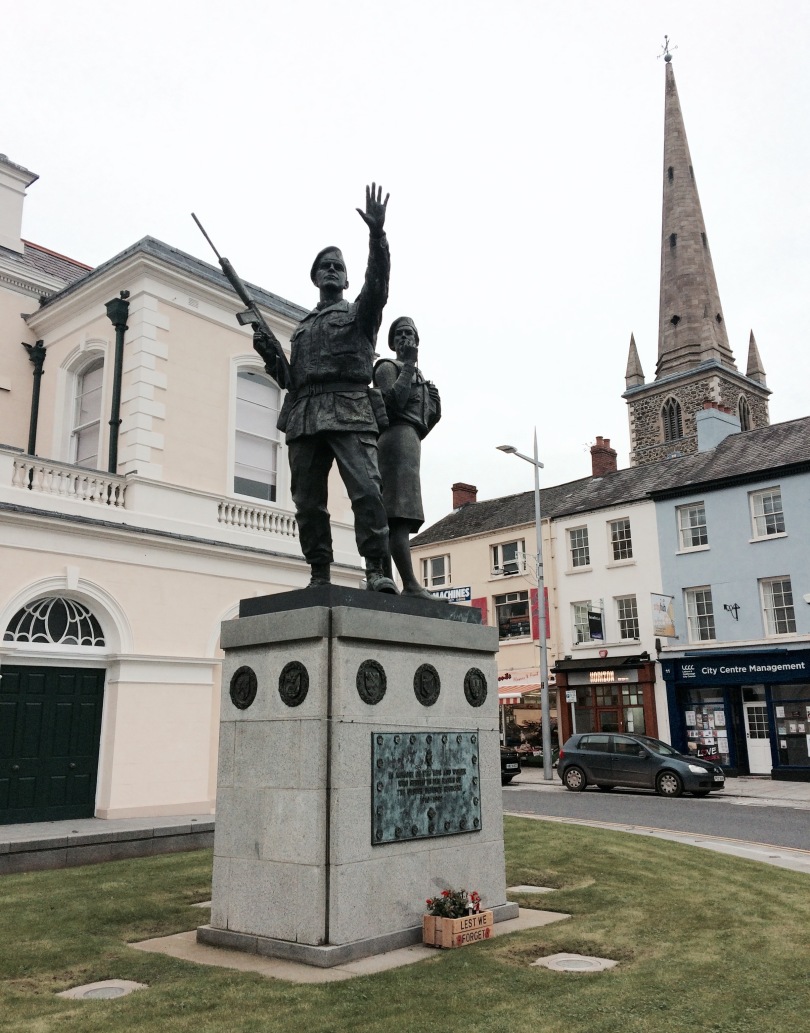I spent a couple of days last week at Thiepval Barracks in Lisburn, where I’d been invited to speak to the personnel of 38 (Irish) Brigade about the history and memory of the First World War. It was an odd but fascinating trip. There was a time in my life when a British army base in Northern Ireland was the last place on earth I would have expected to find myself, but today it seems like a natural enough destination for someone interested in the complexities of the British commemoration of war. The barracks must have been a real hive of activity during the Troubles when there were over 22,000 British soldiers stationed in the region, but it’s a remarkably quiet place now, with an atmosphere that feels either peaceful or foreboding depending on the hour of the day. It was named after the village in the Somme Valley through which the 36th (Ulster) Division advanced and suffered terrible losses on 1st July 1916. For many in the Unionist community, the blood sacrifice of Ulster soldiers on that day purchased the right of the six counties to remain within the United Kingdom, and the memory of the battle is still extremely resonant in Northern Ireland. An elegant granite memorial in the grounds of the barracks commemorates ‘the splendid action fought by the 36th Division’ on the Somme, and servicemen and women stationed there have always venerated those who died in France.

A small museum in Lisburn town, just a short drive from the barracks, tells the story of the area during and after the Great War. It also features a refreshingly objective and engaging exhibition on the impact of the Reformation in Ireland. The advent of evangelical Protestantism in Europe cast a very long shadow in places like Lisburn and historical episodes of ideological violence and sectarianism are still very publicly remembered in the town. One of the panels in the museum gives visitors a fairly unvarnished account of the killing of Detective Inspector Oswald Swanzy of the Royal Irish Constabulary in August 1920. Swanzy had been implicated in the murder of Tomás Mac Curtain, the Republican Lord Mayor of Cork, and was shot dead by IRA gunmen in Market Square. His death provoked an outburst of violence against local Catholics, many of whom were forced to leave Lisburn forever. Swanzy was buried in Dublin, but a brass plaque in the Anglican cathedral across the road honours his memory and that ‘of all his gallant comrades who gave their lives in the unfaltering discharge of their duty’. Just outside the entrance to the museum, a memorial to the Ulster Defence Regiment acts as a very stark reminder of the violence and division of the much more recent past. The memorial was erected just six years ago and takes the form of two larger-than-life statues of a male and female soldier. The UDR recruited locally and was composed almost exclusively of men and women from the Unionist community. Despite a vetting process, the regiment was infiltrated by Loyalist paramilitaries and was viewed with suspicion and distrust by nationalists. There should be little doubt, however, that the UDR, whose headquarters used to be at Thiepval Barracks, suffered a great deal during the conflict. Almost 200 members of the regiment, including four servicewomen (or Greenfinches), were killed between 1970 and 1992.

Lisburn is a pleasant market town with an interesting and complex heritage, by no means all of which is bleak and divisive. I found its people warm and friendly, and the officers and men of 38 Brigade couldn’t have been more welcoming to me. But territorial understandings of the past have divided communities there for four hundred years and history hangs quite heavy in the air. The poppy, it need hardly be said, is not worn lightly in this part of the world and remembrance is still loaded with the weight of historical injury. Commemoration of the two world wars is always political in Northern Ireland and can still be very divisive. And yet people in the North, and indeed across the border in the Republic, have shown a great willingness in recent years to revisit and re-imagine their history. Cross-community and cross-border acts of commemoration are reasonably common today, and public gestures that would have been unthinkable a couple of decades ago are made every year. It’s not enough, of course, and we’d be naïve indeed if we thought that perfect harmony could prevail in a region in which so many were killed within living memory. The devolved government at Stormont has ceased to function, and the now likely return of a hard-border with the Republic threatens to jeopardise years of bridge-building and diplomacy. But the conflict in Northern Ireland has forced people in both communities, and on both sides of the border, to try to adopt a more complex and inclusive view of their history, and the tone in which people talk about the past tends to be much less rancorous than it used to be.
Back in Britain, the challenges of commemoration seem less visceral and certainly less fraught with the potential for violence than in Northern Ireland, but, in cultural terms, the way British people remember the dead of the world wars is a more important issue than we perhaps realise. And it definitely seems to be changing. When I returned to London, I was struck by the bitter tone of much of the media commentary on remembrance in general and the poppy in particular. Statements about the importance of supporting the armed forces past and present on the one hand and denunciations of ‘poppy fascism’ on the other are nothing new, but the public conversation about commemoration seems more antagonistic now than ever. A nasty undercurrent of righteousness has crept into the online commentary on remembrance and the act of wearing the poppy now seems to be dividing people along political lines. Those who wear the symbol ‘don’t want to be told’ that they shouldn’t wear it, and those who choose not to wear it ‘don’t want to be told’ that they should. The reality, of course, is that no one is really telling anyone else what to do, but the ubiquity of the poppy and the transformation of a solemn moment of reflection into a ‘remembrance season’ understandably makes some people uneasy. The frankly absurd spectacle of a muppet wearing a poppy, as the Cookie Monster did on the One Show last year, rightly led to mockery and derision, and some bizarre cases of poppy proliferation have been highlighted on social media over the last few weeks. The poppy ‘onesies’ sold on the Royal British Legion website strike me as particularly weird and incongruous. When the poppy is everywhere, the act of wearing it inevitably becomes less meaningful and less dignified. Indeed, the constant call to remember doesn’t really seem to make people more conscious of the past, but it does increasingly seem to wind them up in the present. I may be wrong, but commemoration seems to have become more about performance and making a statement than it used to be. It’s as if we’re less interested in remembering and more concerned with pinning our colours to the mast in an increasingly polarised political and cultural landscape.

And that’s a shame. I grew up in a country that was fundamentally transformed by the First World War but where there was no popular or political interest in remembering the conflict. People were constantly, obsessively aware of the past, but their understanding of it was selective and they didn’t really ‘come together’ to remember anything. Those who wore poppies did so discreetly, behind the closed doors of Protestant churches and schools. So when I first started coming to Britain – about fifteen years ago now – I was quite struck by what appeared to be a genuinely unifying national force. The annual wearing of the poppy seemed to transcend political, cultural, regional and racial divisions. As such, it seemed like a truly ‘British’ custom. I don’t wear a poppy myself and I remain ambivalent about the real meaning of the symbol, but I have been impressed, as an outsider, by the dignity, and the genuine unity, with which the British have traditionally remembered their dead. I realise now that many people probably always felt alienated in the weeks leading up to Remembrance Sunday, and also that the wearing of the poppy became much more of a public obligation after the invasion of Iraq in 2003. But the great majority of people who wear the poppy do so because they want to express solidarity both with their ancestors and with the servicemen and women of today. They certainly shouldn’t be condemned for this. But nor should those who don’t feel comfortable wearing the poppy, for whatever reason. The stakes are perhaps higher in Northern Ireland, but commemoration of the past has clearly become quite a contentious issue in Britain too. Remembrance doesn’t have to be divisive, but if we treat it as a parade or a civic duty, it most certainly will be.
Edward Madigan is Lecturer in Public History and First World War Studies at Royal Holloway, University of London

Thoughtful stuff. But I don’t entirely agree. (This is probably rooted in a difference between growing up in GB compared to Ireland). The years when wearing a poppy was simply a ‘British custom’ were also years when I think there was little serious public reflection on what remembrance meant. It was becoming a rather empty ‘heritage’ act for many people.
I’m also not convinced remembrance was as happily inclusive as this piece implies. RBL to its credit embraced multiculturalism quite early (and there was also a hangover of ‘imperial = commonwealth’ commemoration) but the political right and much of the public always associated ‘war dead’ with ‘white’ .
There ought to be a happy medium where there can be serious discussion and argument about the meaning of wars and symbolic commemoration without embittered polarization around these symbols.
LikeLike
I see what you mean Adrian, you’re not wrong about the right’s understanding of the dead as white, and I’d certainly defer to your perspective as an Englishman, and indeed as a cultural historian of Britain. But I’d encourage you to consider what British commemorative culture has looked like to a reasonably well-informed foreigner over the past fifteen years or so. What I’ve written here is only impressionistic, but it certainly seemed as if remembrance of the dead of the two world wars, invariably expressed by the wearing of the poppy, was not ‘owned’ by the right ten years ago. It also seemed as if a great many people, from all walks of life, classes, regions and, yes, races were content to wear the poppy. Commentary regarding commemoration – either positive or negative – also tended, I think, to be much less antagonistic than it is now (but of course social media is such a different animal these days, and it may simply be that people have more of a public platform for long-held rancour). Consider also that even those who never wear a poppy, and decry ‘poppy fascism’ online and elsewhere, would still usually claim to respect and honour the dead of the two world wars. So while people feel increasingly uncomfortable with commemorative culture, there’s an extraordinarily broad consensus that the war dead are deserving of reverence and respect. This sort of general agreement in spirit pertains to almost nothing else in British national life, and suggests that commemoration could be a nationally unifying force, or at least doesn’t have to be as divisive as it increasingly appears to be.
LikeLike